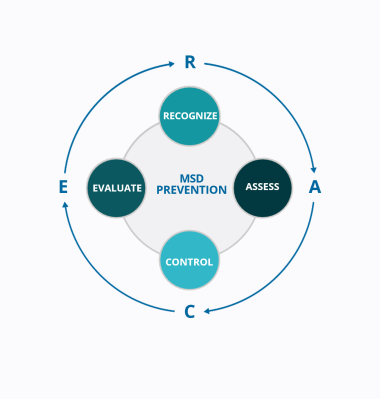
Recognize, Assess, Control, & Evaluate MSD Hazards
There are specific approaches to recognizing and assessing MSD hazards and selecting and implementing controls. Key hazards include lifting from the floor; twisting when lifting; working with arms overhead; holding objects or tools for extended periods, especially in a non- power grip; using vibrating tools; prolonged standing and extended hours working with a computer. Assessment methods range from simple screening questions to quantitative methods. Training on these specific topics by competent instructors should be done. Participation of workers in MSD Prevention activities is especially important.

Understanding MSD
Musculoskeletal Disorders (or MSD) at work is an umbrella term for a number ofdifferent kinds of injuries and disorders of the muscles, tendons, ligaments, bone and nerves. Many body areas can be affected. The low back is the most commonly frequently affected, followed by the shoulders, neck, elbow, hands and wrists.
Common physical hazards that can lead to MSD include:
- High forces
- Awkward postures
- High repetition
These hazards can be found on their own, or in combination with each other. Other hazards that can lead to MSD include vibration, local contact stress, and temperature (cold).

Rights and Responsibilities
In Ontario, “The employer, typically represented by senior management, has the greatest responsibilities with respect to health and safety in the workplace and is responsible for taking every precaution reasonable in the circumstances for the protection of a worker.
The employer is responsible for ensuring that the [Internal Responsibility System] IRS is established, promoted, and that it functions successfully. A strong IRS is an important element of a strong health and safety culture in a workplace. A strong health and safety culture shows respect for the people in the workplace.”
Guideline Information
Relevant Resources
Additional Resources for Employers and Managers
View a curated collection of resources in the resource library.

Want to search the resource library?
Find all the available resources on the MSD prevention website, including posters, videos, and links to relevant websites.


